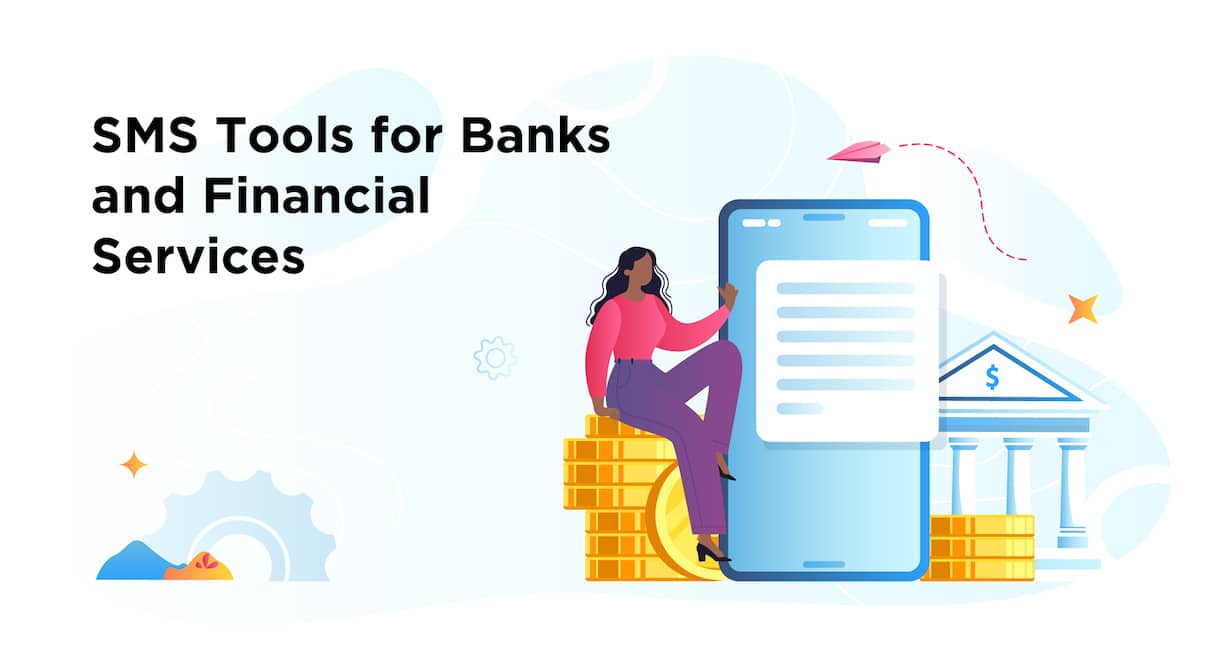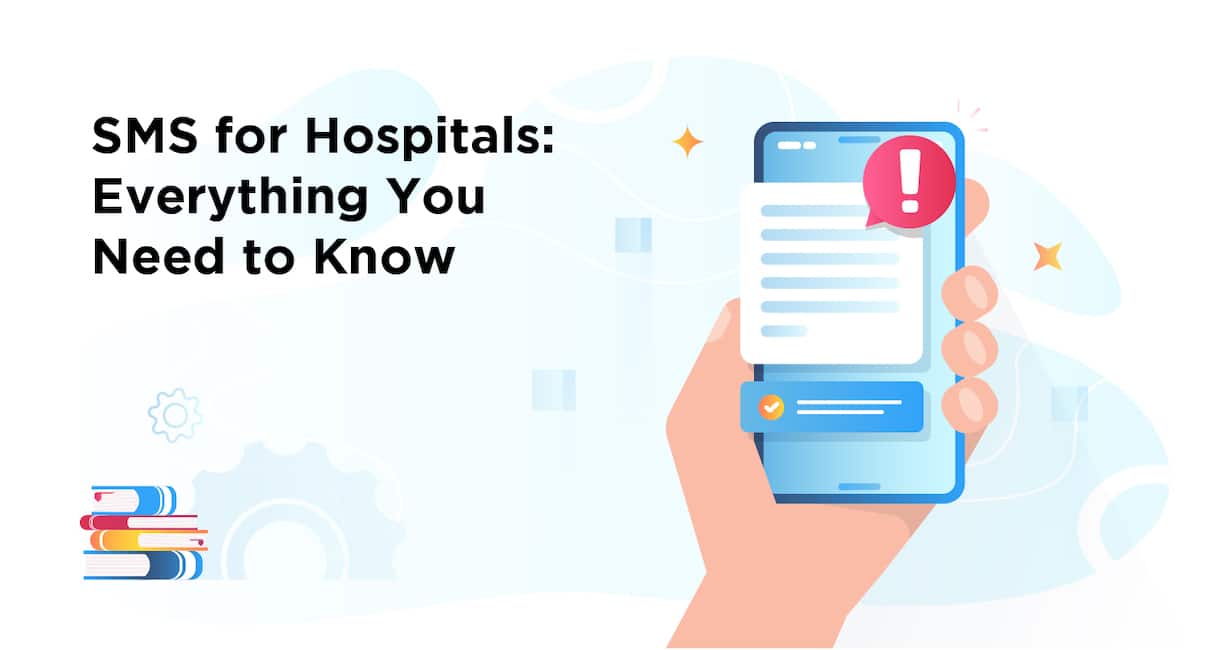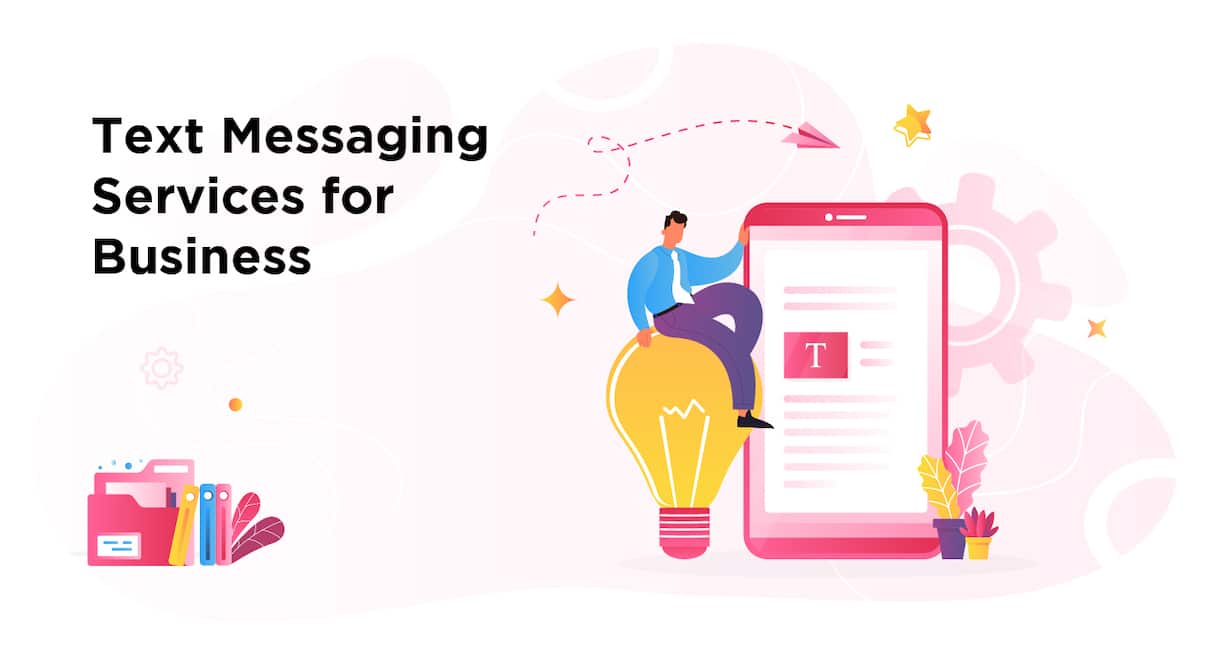While email may be the most popular form of workplace communication, using text messages to communicate with employees is becoming increasingly popular. Text message employee communications have several benefits over email. These include a fast and easy-to-use interface, lower cost for both you and your employees, and increased employee engagement.
Communicating with employees via text is the latest internal communications best practice for a dispersed, modern workplace. But it doesn’t come without its rules.
Want to learn the most effective ways to use text messaging in the workplace?
In this guide, we’ll cover some of the best practices and tips for employee text communication. We’ll also provide professional text message examples to show you how to truly use texting to reach employees.
With the right tools and best practices, you’ll be able to optimize text messaging for employee communication, engagement, and productivity in no time.
Take a self-guided tour of ContactMonkey
See how our key features can streamline your internal communications.
Take product tour

A Guide for Using Text Messages to Communicate With Employees
Why use text messages?
Employee communication text messaging is a fast, efficient, and cost-effective way to communicate with your employees. Compared to email, employee text messaging for internal communications offers several unique benefits. These include a simple and easy-to-use interface, lower costs for both you and your employees, quicker communications, extended reach, and increased employee engagement.
To get the most out of workplace messaging and texting, it’s important to follow a few employee text messaging best practices. We’ll show you how to follow these best practices for effective internal communications by creating a consistent tone of voice, sending timely messages, and using emojis to express your message in more fun and captivating ways.
Text messaging services for business
Some practical examples of how you can use text messaging to communicate with your team include using it for urgent updates or announcements, to group text employees who work remotely, and using texting to check in with your team or provide feedback.
How to make employee text messages effective
There are five key strategies you can use to make text messages an effective tool for communication in your workplace. These include creating a consistent tone of voice, sending timely messages, choosing the right medium for your message, using emojis and other visuals to enhance your message, and offering incentives or rewards to encourage participation.
Setting a consistent tone of voice: One of the most important aspects of effective text messaging is setting a consistent tone that your employees can rely on. This means being clear and concise in your messages. You can also use emojis to express emotion or illustrate key points, and avoiding slang or informal speech. Just be sure there is a clear and easy-to-follow texting etiquette for employees.
Sending timely messages: Another key factor in effective texting is sending your messages at the right time. This can be especially important for urgent updates or announcements, when it may be necessary to send messages outside of regular business hours.
Choosing the right medium: In addition to choosing a consistent tone of voice, you should also carefully consider which medium is most appropriate for each message. For example, messages that require a quick response might be better suited to group texts, while more complex or in-depth topics may be better communicated via email instead.
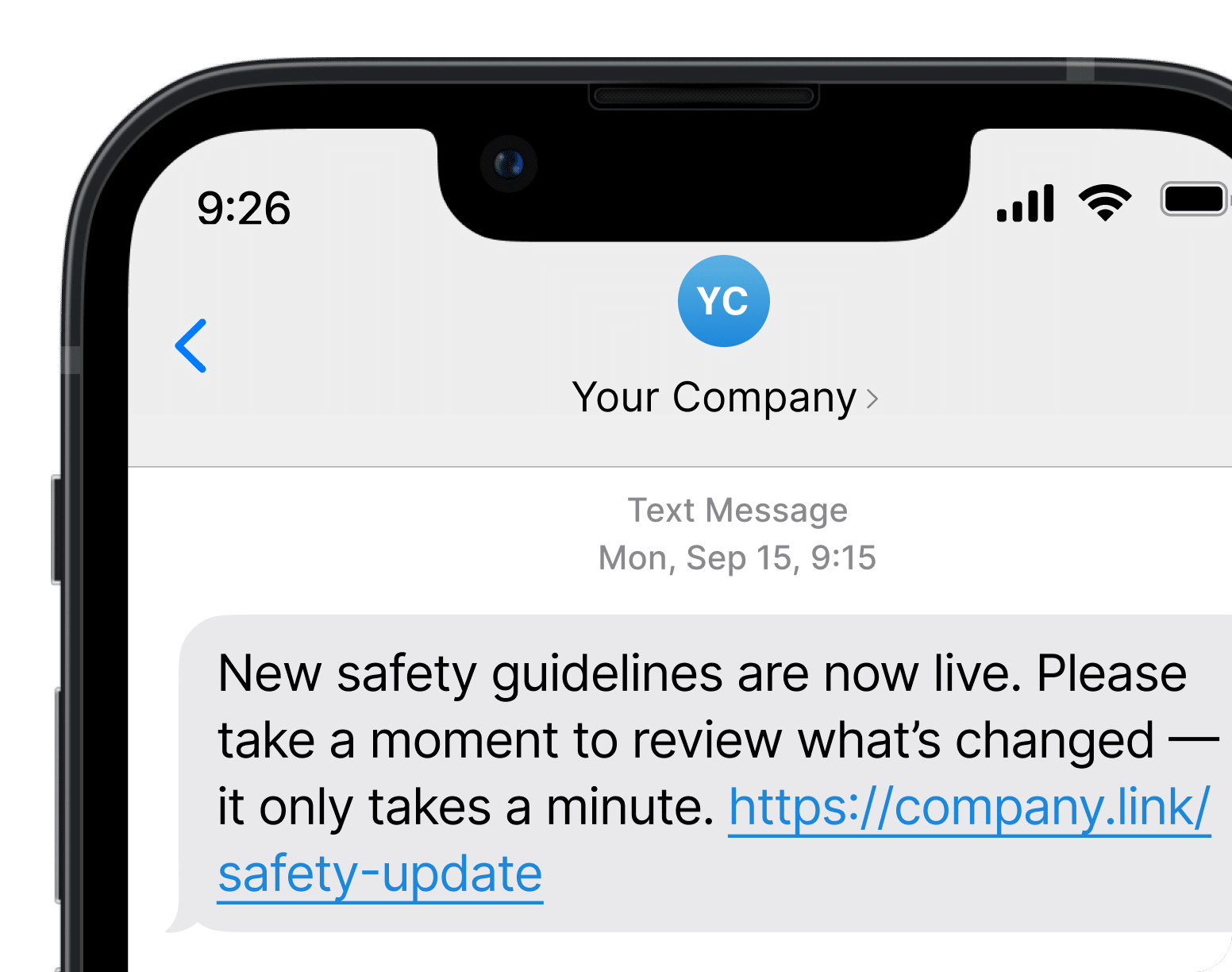
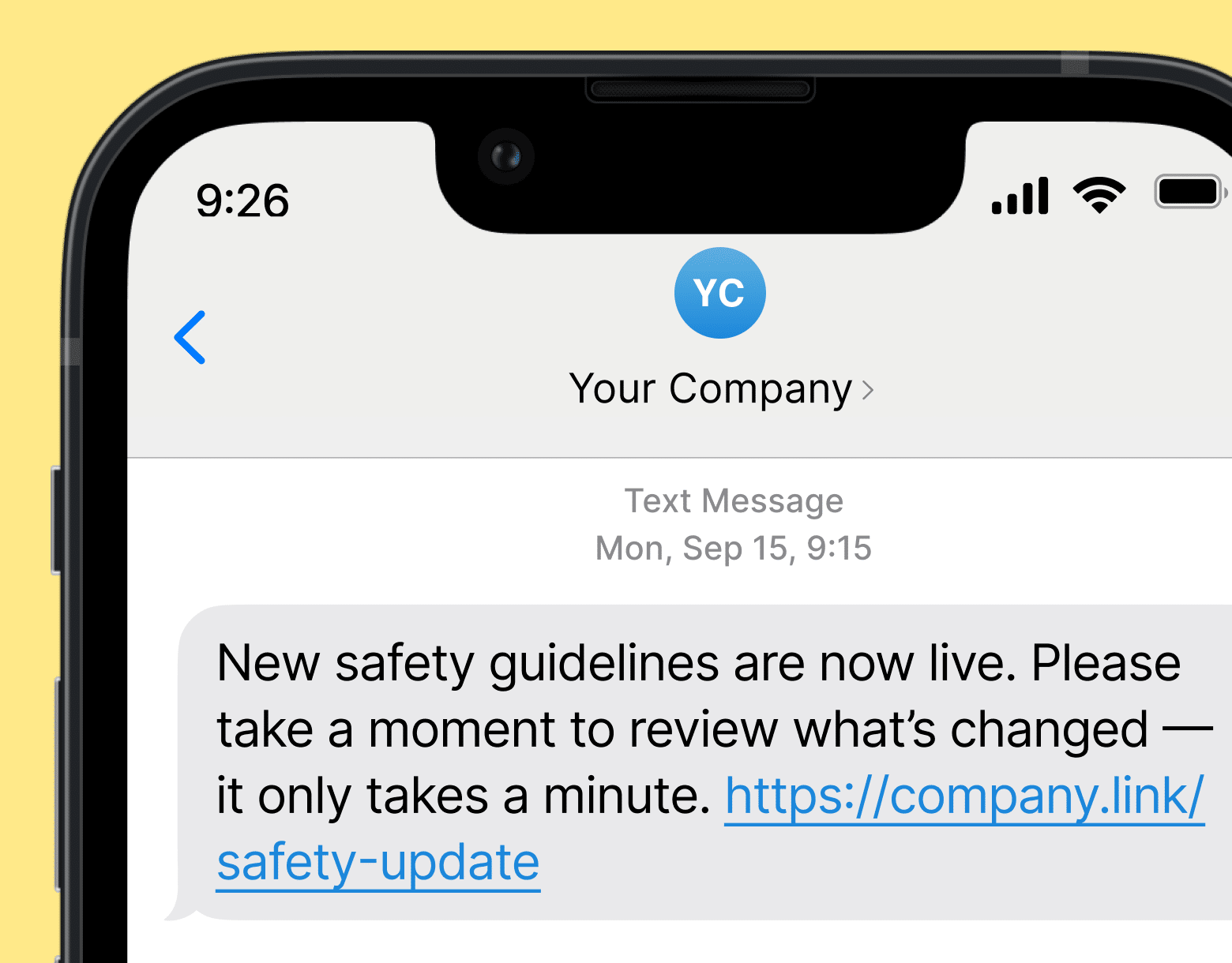
Using visuals: Text messages are a great way to include visuals such as emojis, images, or GIFs that help enhance your message and make it more engaging for your recipients.
Incentivizing participation: Finally, you can also use incentives or rewards to encourage participation among your employees. This may include offering small perks, such as free coffee or lunch, for those who respond to your messages in a timely manner. It can also include larger prizes for team challenges or contests that promote teamwork and collaboration.
How to start communicating effectively with texting in the workplace
Employee text communication has lots of uses. But communicating effectively with texting in the workplace requires understanding the unique nature of this type of communication
. To get started with texting at work, there are four basic steps that you can follow.
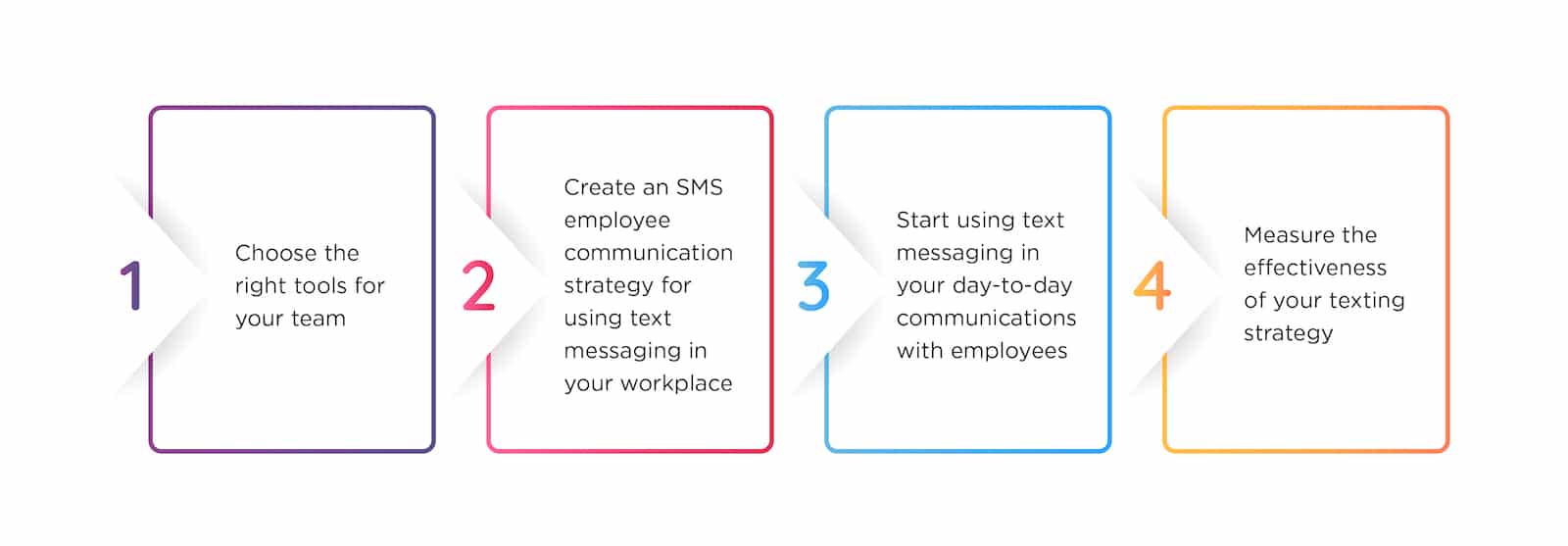
The first step is to choose the right tools for your team. This may include selecting a text messaging platform that offers features such as message scheduling, automatic replies, and customizable templates for frequently used messages.
The second step is to create an SMS employee communication strategy for using text messaging in your workplace. This may involve establishing clear guidelines for sending messages, setting up automated responses, or developing a system tracking and responding to replies from your team.
The third step is to start using text messaging in your day-to-day communications with employees. This may involve scheduling regular updates and announcements via group texts, connecting with remote workers via one-on-one conversations, or using text messages to facilitate team collaboration and project management.
Finally, the fourth step is to measure the effectiveness of your texting strategy and make any necessary adjustments based on feedback from your team. This may include conducting an internal communications audit by analyzing metrics such as open rates, response times, or response rates to identify areas for improvement.
With these steps in place, you can start using text messaging at work. This can improve communication and collaboration among your team members, boost productivity, and drive business success.
The Most Popular Situations for Employee Text Messaging
Text messaging for employee communication opens up a wide range of engagement possibilities. This includes the ability to send simple reminders and announcements as well as completing more complex tasks like project collaboration or gathering employee feedback.
Here are some of the most popular use cases for text message employee communications:
1. Use text messages as part of a mass notification solution for SMS emergency alerts, urgent updates, or mass employee notifications about schedule changes, projects, or other key information.
Here are some professional text message examples:
- “Due to inclement weather, all employees will be working remotely today. Please follow the link below to join our team call.”
- “Important update: The deadline for submitting your project proposal has been extended by one week.”
2. Send a text message to check in with the team and see how they’re doing, or provide them with employee feedback on their performance.
Some inspiration for you:
- “How are things going on your team project? Can you provide a quick status update? Let me know if there’s anything I can do to help.”
- “I really appreciate the hard work and dedication you’ve been putting into this project. Keep up the great work!”
3. Set up group texts to stay connected with remote workers, and encourage them to share their ideas or feedback in these channels.
Professional text message examples include:
Reach employees instantly with SMS
Send important updates straight to your team’s phones.
See SMS pricing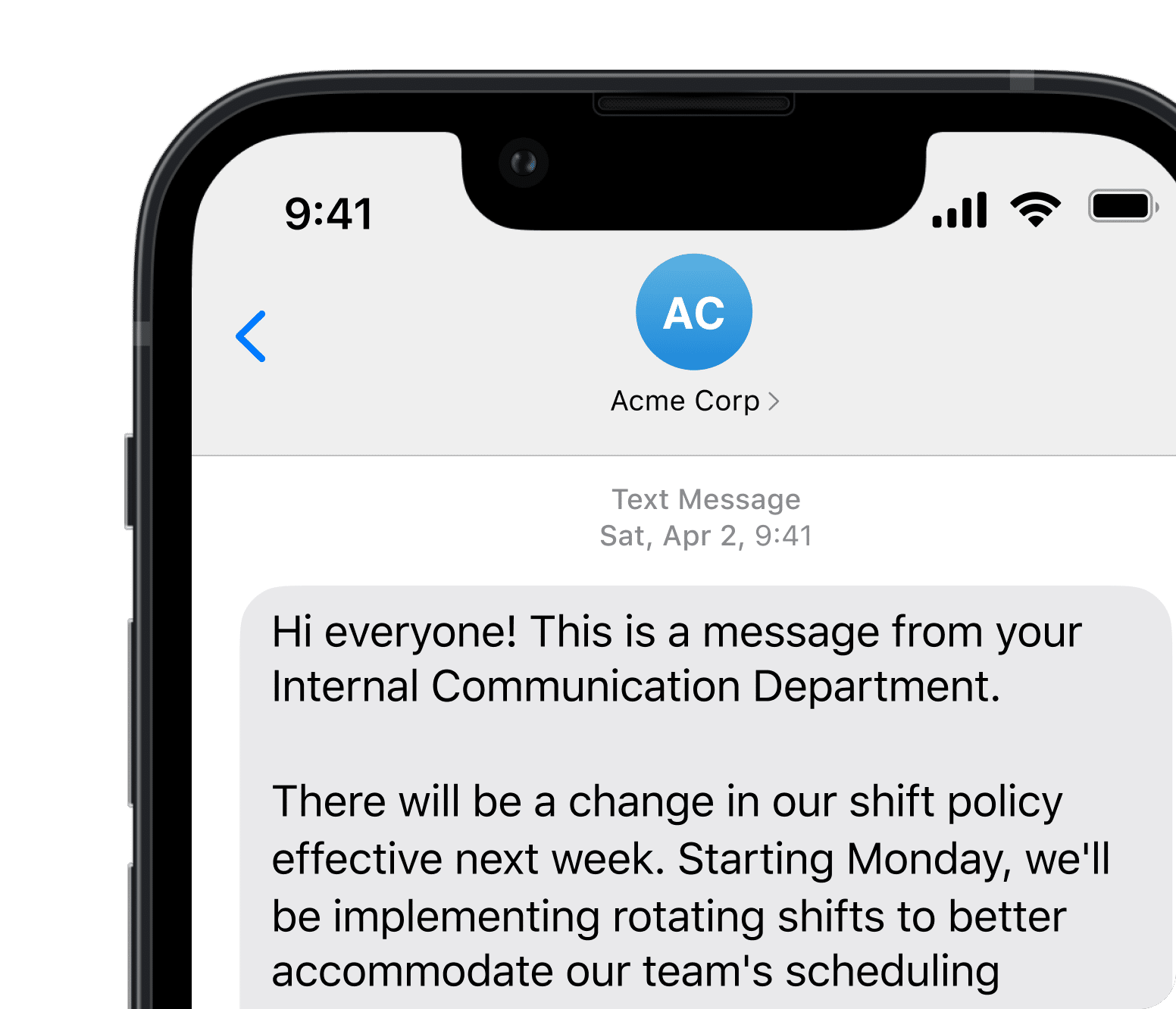
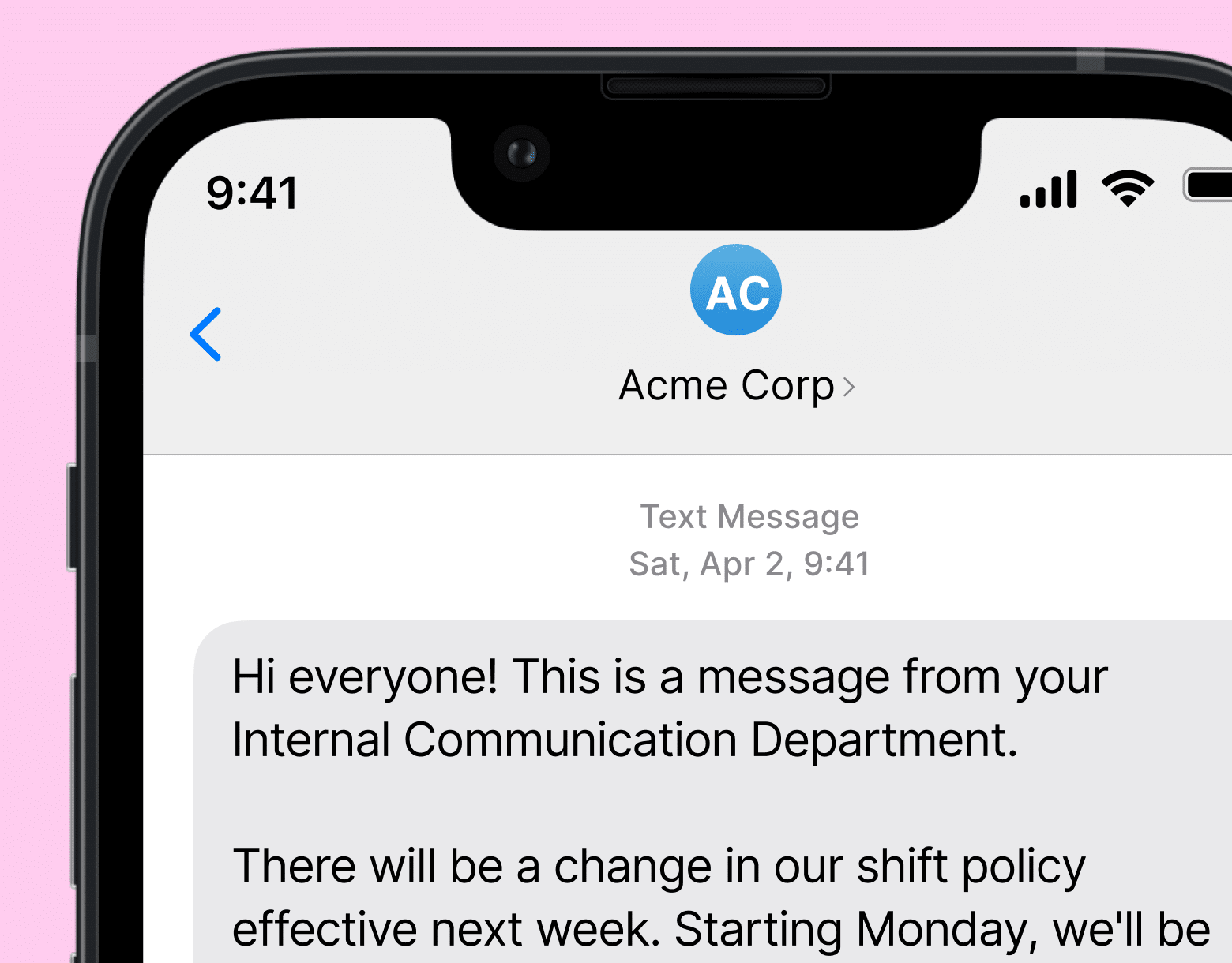
- “Hey everyone, we’re looking for feedback on the upcoming product launch. Feel free to share your thoughts and ideas here!”
- “We are using text to provide updates on this new initiative. Please make sure to check in regularly and update your team members on any changes or updates.”
4. Use text messages as a tool for employee onboarding, providing documentation or instructions, or answering questions about processes or policies.
Some examples include:
- “Here is the link to our onboarding portal. It contains all of the information you need about your new role and responsibilities.”
- “I’m happy to answer any questions or concerns you may have about our company policies. Please feel free to send me a text or email at any time.”
5. Include emojis, GIFs, or other visual cues in your messages to help express your message clearly and concisely, and to make your messages more engaging for employees.
Here are a few examples of communicating effectively with texting in the workplace:
- “Please see the attached document for more information about the new project.”
- “Great work on the last round of product launches! Here are a few GIFs to help keep you motivated and on track.”
6. Encourage employees to respond to texts within a certain timeframe, such as within 24 or 48 hours, and set expectations around response times when texting team members.
Here are some ideas for employee communication text messaging to get you started:
- “Please let me know if you have any questions or concerns within the next 24 hours.”
- “In an effort to keep our communication as efficient and timely as possible, we ask that you respond within 48 hours.”
7. Use text messaging for internal communications to share updates on projects or milestones, provide performance feedback, or share information on training opportunities or professional development programs.
You can use these professional text message examples:
- “I just want to let you know that the new marketing campaign has been launched, and we are seeing great results so far!”
- “Your performance on this project has been exemplary. I look forward to working with you on future initiatives.”
8. Integrate employee text communication with other internal collaboration tools, such as instant messaging platforms, team chat rooms, or project management software, to create a more seamless experience for employees and stay connected at all times.
Some employee text messaging examples might include:
- “Please join me in our team chat room for a quick meeting to discuss the latest updates on this project.”
- “I’m going to add you to our project management platform so that you can easily view and update your task list.”
9. Send personalized text message employee communications to individual team members to drive employee engagement and retention.
For inspiration, you can steal these SMS message examples for text messaging in the workplace:
- “Hey John, I just wanted to check in with you and see how things are going on your team. How can I help?”
- “Team, thank you for all of your hard work on this project! We couldn’t have done it without you.”
10. Text employees with news about promotions, new roles or responsibilities, or opportunities for career development with a CEO message to employees.
Here are some examples of how you can use texting to reach employees:
- “I’m happy to announce that [employee name] has been promoted to Team Lead! Please let me know if you have any questions or concerns about their new role.”
- “We are currently looking to fill a position on our management team. I wanted to see if you’d be interested in applying. Feel free to reach out with any questions.”
11. Use text messages to send congratulatory messages when employees achieve a major goal or milestone, complete training or certification programs, or hit personal goals like weight loss or running a marathon. Employee text messaging for internal communications is a great resource to be creative with your employee recognition ideas.
For example, you might say:
- “Congratulations on your recent promotion! I’m proud of all the hard work you’ve put in to get where you are today.”
- “I’m so impressed with your progress on the new project. Keep up the good work. I know you will achieve amazing results!”
12. Host group texts with small groups of employees or team members to discuss issues related to their work, share ideas with one another or provide feedback on projects or initiatives.
A few great employee text communication examples would be:
- “Let’s try to come up with some new ideas for our next team meeting. Who wants to start?”
- “Can everyone please provide their feedback on the latest draft of the sales presentation? I’ll send a group text when we’re ready to discuss.”
13. Use text messages as a way to let employees know when they should expect communications from you or check in about how things are going at work.
Some text message employee communications examples might include:
- “I’ll be sending out a weekly report on our team’s progress via text, so make sure you’re checking your messages regularly.”
- “Please let me know if there is anything we can do to help support you and your team during this busy time.”
14. Send employee text message communications to provide staff with reminders about key deadlines, meetings, or events, or to give them advance notice of any schedule changes or new processes that they’ll need to follow at work.
Here are some workplace messaging and texting examples to get you started:
- “I wanted to remind everyone that the quarterly performance review is due next week. Please take some time to prepare for your meeting with your manager.”
- “I’ve just sent out an email with more details about the upcoming team retreat. Please read it carefully and let me know if you have any questions or concerns.”
15. Use text messaging for employee communication as an effective tool for remote employee engagement and setting expectations around how they should communicate with key stakeholders and work with their team members.
Some examples for communicating with employees via text might include:
- “I just wanted to reach out and check in on how you’re settling into your new role. Please let me know if you need any help getting started with any of the new systems or processes here at the company.”
- “I wanted to make sure you have all the information you need to start working from home. Please review our remote work guidelines. Let me know if you have any questions or concerns.”
16. Send text messages to employees who are working from home or on the road, and make sure that they know how to best communicate with colleagues via mobile devices and encourage a culture of remote team communication.
Here’s some inspiration for using text messages to communicate with employees:
- “Hey! I wanted to reach out and check in on how things are going. Is there anything I can do to help you stay connected and productive while working from home?”
- “Hey, just wanted to check in and see how you’re doing on your first day working from home. I know it can be a bit of a transition, so let me know if you need any help getting set up or if there’s anything I can do to make the process easier for you.
17. Text individual team members or groups of employees to provide information about new projects, tasks, or initiatives within the company, and make sure that they have the resources or training they need to succeed.
Some examples of using text messages to communicate with employees might include:
- “I’m excited to announce that we will be rolling out a new initiative next month focused on improving workplace productivity. Please make sure to review the project details and let me know if you have any questions or concerns.”
- “I hope everyone is ready for our upcoming training on the new sales software! Can you please go over the training materials and familiarize yourself with the new system in the next week or so?”
18. Send daily motivational messages, funny GIFs, or other visual cues to help employees feel more connected to their colleagues and motivated in their jobs. This is a great way to promote a strong company culture.
Here are some ideas for you:
- “Let’s all take a few minutes to kick back and relax today. Remember, it’s important to take time for yourself and your well-being at work!”
- “Remember to keep a positive attitude and don’t let any setbacks or obstacles get in your way! You’re more than capable of achieving anything you set your mind to.”
19. Encourage your team members to share positive feedback about one another’s work via text message, and let them know that they can always use this channel to ask questions or share ideas with each other. This can be an effective strategy for how to collect employee feedback.
Some possible messages might include:
- “I just wanted to pass along some positive feedback about the amazing work you’ve been doing on our recent project. Keep up the good work!”
- “I was wondering if anyone had any ideas or suggestions for how we can improve our workflow or make our processes more efficient. I’d love to hear your ideas!”
20. Use text messaging as a way to improve employee satisfaction and engagement, by sending regular reminders about company goals and encouraging employees to participate in surveys or discussions. There are several types of employee surveys to keep your team engaged.
These are some possible messages to use:
- “Our next company-wide survey is coming up soon. I hope that all of you will take the time to complete it and provide your honest feedback on how we can improve our workplace environment.”
- “We’re currently highlighting all of the great work that our teams have been doing. I would really love it if you could share some of your accomplishments or feedback on how we can continue to grow and succeed as a company.”
21. Host group texts where small groups of employees can follow-up questions about important meetings or discussions, or even ask important company culture questions. Make sure that this channel is available for use in case they need any additional clarification.
For example, you might use these employee text messages:
- “Thanks to everyone who was able to make it to the team meeting this morning. I know that a lot of you had some great questions. Please feel free to continue the discussion by joining our group text today.”
- “I’m here in case anyone needs any additional support or information on the new project. Please don’t hesitate to reach out if you have any questions or concerns. I will do my best to get back to you as soon as possible.”
22. Encourage individual team members to send texts to colleagues when they need assistance with a project or task, or want support from other team members who have expertise in a certain area.
Here are some examples of how you could be using text messages to communicate with employees:
- “Let me know if you’re having some trouble with the new software. I’m happy to offer support wherever you need it!”
- “How are you feeling about this project? We can always set up some extra support or guidance from a more experienced team member. Is there anyone on our team who you’d like some help from with this?”
23. Send texts to provide employees with change management communications, and make sure that they’re aware of any new resources available to them as a result of these shifts.
We’ve seen lots of examples including:
- “We have some great news to share with all of you today. We are officially moving to a new office space in the next few weeks. This will bring with it a lot of new and exciting opportunities for our team. I hope that you can all join me in celebrating this transition as we look forward to the future of our company!”
- “We have recently made some changes in the organizational structure. I wanted to let all of you know that we are now providing a new team of experts. If you ever need support with a specific project, please reach out to this new group for help.”
24. Share regular updates via text message employee communications during important public events like conferences, trade shows, or industry-related expos where employees will be present, to help them stay connected with management and each other.
If you’re looking for inspiration, you can look at these professional text message examples:
- “The conference is officially starting, and I just wanted to send out a quick text to all of you before the first session begins. I hope that you are all having a great time. And I look forward to hearing about your experiences when you get back on Monday.”
- “I’m so excited to be a part of this expo, and I know that it’s going to be an amazing opportunity for all of us. If you have any questions or need any help while you’re there, please feel free to reach out to me. I’d love to hear more about what you’re doing and how our company can benefit from it.”
25. If you’re running low on holiday employee engagement ideas, workplace messaging and texting might be an interesting solution for you. Use text messages as a way to connect with employees during important company events. This can include awards banquets, holiday parties, or team lunches. These messages make sure that they know how to easily get in touch with management if they need anything.
A few more examples of communicating effectively with texting in the workplace:
- “The holiday party is just around the corner. And I wanted to let all of you know that I am so proud of everything that we have accomplished this year. I hope that you can all join me in celebrating our success with a fun night out together. Don’t forget to get your tickets on time!”
- “I hope that you all had an amazing time at the team lunch today. I just wanted to check in and see if there was anything that any of you needed or wanted. Please don’t hesitate to let me know. I will do my best to get the ball rolling on it right away.”
The Best App Using Text Messages to Communicate With Employees
Communicating with employees via text is non-negotiable in today’s fast-paced modern workplace. Employee SMS was designed with the ever-changing, always-on-the-go workforce in mind. Healthcare personnel, distribution workers, and retail staff don’t always have access to their emails—but that doesn’t mean they can’t receive time-sensitive updates. And with the help of text messages delivered straight from any location onto everyone’s personal devices, staying connected is easier than ever before!
With ContactMonkey, you can get started with text messaging your team right away, and take advantage of our tools to streamline your internal communications management.

